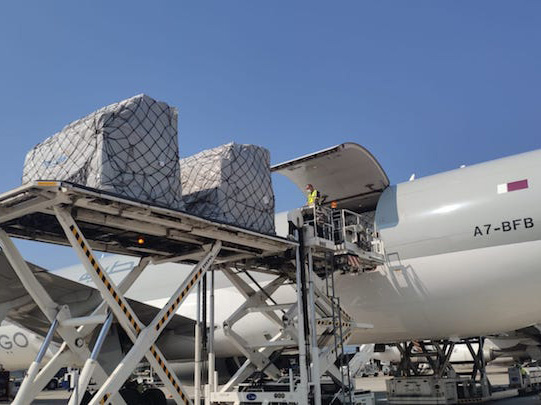
Qatar Airways has today published its Annual Report for 2019-20, highlighting the airline group’s resilience in the face of the continued illegal airspace blockade against the State of Qatar and the most challenging period in global aviation’s history.
Qatar Airways is familiar with facing exceptional challenges; however, 2019-20 has been one of the most difficult years in the airline’s history. The combination of the ongoing illegal air space blockade against the State of Qatar, the liquidation of Air Italy by the majority shareholder, changes to accounting policy and reporting standards and the COVID-19 pandemic crisis has resulted in the Qatar Airways Group reporting a net loss of QAR 7 billion for the year 2019-20. Excluding these exceptional items, the Group’s results at both operating and net levels would have been better than that reported in the year before clearly demonstrating the Group’s improving performance.
Qatar Airways Group Chief Executive, His Excellency Mr. Akbar Al Baker, said: “Despite the momentous challenges our Group has faced in 2019-20, Qatar Airways Group continues to remain resilient, reporting strong underlying fundamentals. If not for the exceptional circumstances of fiscal year 2020, our results would have been better than the year before.
“During the fiscal year 2020, the Group’s revenue increased to QAR 51.1 billion, seat capacity increased by 3.2 per cent, freight tonnes handled increased by 2.8 per cent and passenger traffic at Hamad International Airport increased by 8.6 per cent. Qatar Airways invested QAR 16.8 billion in fleet and other assets during the year and had a cash balance of QAR 7.3 billion at year end. Significant progress has been achieved in the three-year transformation plan, which began pre-COVID-19 and will position the Group’s operations and practices to meet the current challenges.
“I am extremely proud of the teams, departments and subsidiaries across the Qatar Airways Group that have remained agile throughout this tumultuous period and adapted quickly to this new reality, displaying the tenacity, versatility and commitment to excellence so often associated with everything we do. These efforts are why we have become the largest international airline and air freight carrier since the onset of the pandemic, taking over two million people home safely and reliably and carrying over 250,000 tonnes of medical and aid supplies to impacted regions.
“I have every confidence that the Qatar Airways Group will emerge stronger from this difficult period and continue to innovate and set the standards that our competitors can only hope to emulate. We will continue to be the airline millions of passengers can trust and rely on in good times and bad, and proudly fly the flag of the State of Qatar across the globe.”
Throughout the pandemic Qatar Airways’ network has never fallen below 30 destinations with continuous services to five continents. Since then the airline has rebuilt its network to more than 650 weekly flights to over 90 destinations across six continents offering passengers more flexible travel options via the Best Airport in the Middle East to more destinations than any other airline.
According to the latest IATA data, Qatar Airways has become the largest international carrier between April to July 2020 by fulfilling its mission of taking people home. This enabled the airline to accumulate unmatched experience in carrying passengers safely and reliably and uniquely positioned the airline to effectively rebuild its network. The carrier has stringently implemented the most advanced safety and hygiene measures on board its aircraft and in Hamad International Airport.
Qatar Airways operations are not dependent on any specific aircraft type. The airline’s variety of modern fuel-efficient aircraft has meant it can continue flying by offering the right capacity in each market. Due to COVID-19’s impact on travel demand, the airline has taken the decision to ground its fleet of Airbus A380s as it is not commercially or environmentally justifiable to operate such a large aircraft in the current market. The airline’s fleet of 49 Airbus A350 and 30 Boeing 787 are the ideal choice for the most strategically important long-haul routes to Africa, the Americas, Europe and Asia-Pacific regions.
Qatar Airways’ onboard safety measures for passengers and cabin crew include the provision of Personal Protective Equipment (PPE) for cabin crew and a complimentary protective kit and disposable face shields for passengers. Business Class passengers on aircraft equipped with Qsuite can enjoy the enhanced privacy this award-winning business seat provides, including sliding privacy partitions and the option to use a ‘Do Not Disturb (DND)’ indicator. Qsuite is available on flights to more than 30 destinations including London, Paris, and Frankfurt. For full details of all the measures that have been implemented onboard and in HIA, please visit qatarairways.com/safety.
Qatar Airways’ home and hub, Hamad International Airport (HIA), has implemented stringent cleaning procedures and applied social distancing measures throughout its terminals. Passenger touchpoints are sanitized every 10-15 minutes and boarding gates and bus gate counters are cleaned after each flight. In addition, hand sanitizers are provided at immigration and security screening points. HIA was recently ranked “Third Best Airport in the World”, among 550 airports worldwide, by the SKYTRAX World Airport Awards 2020. HIA was also voted the ‘Best Airport in the Middle East’ for the sixth year in a row and ‘Best Staff Service in the Middle East’ for the fifth year in a row.









